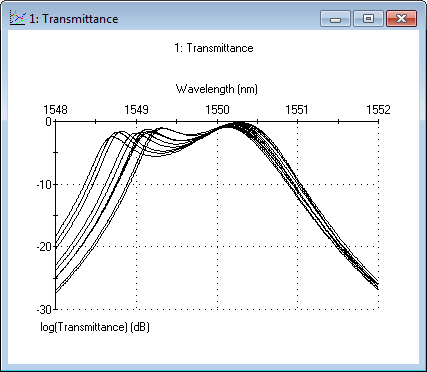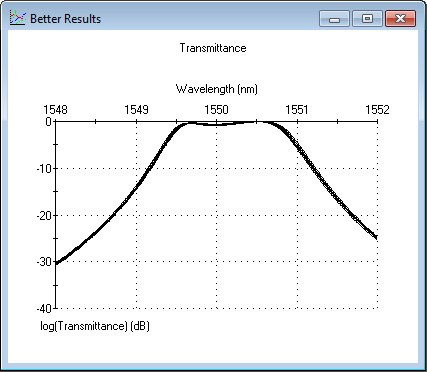SIMULATOR ENHANCEMENT
The Simulator Enhancement is a Monte Carlo model of the production process. A run sheet produced by the Runsheet Enhancement provides the deposition instructions. Simulator then applies features such as noise in the optical signal, errors in quartz crystal monitoring, wavelength setting problems, tooling factor variations, temperature effects, and performs a given number of simulated production runs. Examination of the results permits study of tolerances, assessment of likely success in actual production, and the study of any parameters suspected to be causing difficulties with a particular process. Various kinds of automatic monitoring systems may be incorporated. It can call scripts from the Function Enhancement to simulate special control functions such as wideband monitoring or single point monitoring with special features permitting modeling of almost any type of controller.

An example of some of the results from simulator is shown below. A runsheet was setup to optically monitor all layers of a three cavity narrow band filter. Simulator was used to monitor the production of the filters in the presence of signal noise. The picture above shows the chart recorder style output available when Simulator is running. The picture below shows the results from the all-optical monitoring setup.

We do not achieve any good filters. The reason for this is the well-known problem of optically monitoring the coupling layers. The optical signal during coupling layer deposition is very sensitive to errors that have already occurred. Normal practice is to monitor these layers with a crystal monitor. The accuracy of the crystal monitor is sufficient for these layers (but not for monitoring the entire coating). The picture below shows the results of an updated runsheet where the monitoring plan includes crystal monitoring for appropriate layers and makes the production of the filters possible in Simulator.

An example of some of the results from simulator is shown below. A runsheet was setup to optically monitor all layers of a three cavity narrow band filter. Simulator was used to monitor the production of the filters in the presence of signal noise. The picture above shows the chart recorder style output available when Simulator is running. The picture below shows the results from the all-optical monitoring setup.

We do not achieve any good filters. The reason for this is the well-known problem of optically monitoring the coupling layers. The optical signal during coupling layer deposition is very sensitive to errors that have already occurred. Normal practice is to monitor these layers with a crystal monitor. The accuracy of the crystal monitor is sufficient for these layers (but not for monitoring the entire coating). The picture below shows the results of an updated runsheet where the monitoring plan includes crystal monitoring for appropriate layers and makes the production of the filters possible in Simulator.

We can also see that the filters are shifted relative to their design wavelength of 1550nm. This is an artifact of the type of optical monitor used. The monitor has to see the signal move to the peak and then move away from the peak before it is able to detect the peak, thus it typically produces layers that are a little too thick. A small adjustment to the monitoring wavelength would correct this.
Note that for Simulator to operate correctly the Runsheet enhancement must also be present.
Ordering Information
All products and services may be ordered directly from Thin Film Center or from any of our agents. For your convenience we accept payment by American Express, Mastercard and Visa. Please contact us, or our agents for pricing information.

Thin Film Center Inc
2745 E Via Rotunda, Tucson, AZ
85716-5227, USA
Telephone: +1 520 322 6171
Email: info@thinfilmcenter.com
2745 E Via Rotunda, Tucson, AZ
85716-5227, USA
Telephone: +1 520 322 6171
Email: info@thinfilmcenter.com
